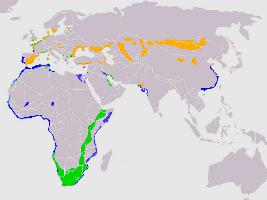
Váhy a míry
| Délka | od 43 do 48 cm |
|---|---|
| Hmotnost | od 290 do 400 g |
| Délka rozpětí křídel | 73 cm |
Stav ohrožení
| Ohrožen |
Popis zvířete
The Pied Avocet (Recurvirostra avosetta) is a distinctive and elegant wading bird that belongs to the family Recurvirostridae, which also includes the stilts. This species is known for its striking appearance and unique foraging behavior. It is predominantly found across Europe and Asia, and in some parts of Africa, exhibiting migratory patterns that vary with season and geographic location.Appearance-wise, the Pied Avocet is a study in contrast and grace. It boasts a striking black and white plumage that makes it easily identifiable. The upper parts of the bird are primarily black, with white underparts that extend up the neck and onto the face, creating a sharp delineation that is particularly eye-catching. One of the most remarkable features of the Pied Avocet is its long, upcurved bill, which is thin and delicate, tapering to a fine point. This specialized bill is not just a distinctive morphological trait but also an essential tool for its unique feeding technique.
The bird's legs are long and slender, colored a pale blue, which adds to its elegant appearance as it wades through shallow waters. The long legs are not just for show; they enable the avocet to navigate through varying depths of water in search of food. The avocet's feet are webbed, aiding in swimming during deeper water foraging and efficient movement through mud and silt.
With a wingspan that can reach up to 77 cm, the Pied Avocet is an impressive sight in flight. Its wings are broad and rounded, with striking black and white patterning that is especially visible during flight. This patterning is not just visually appealing but serves as a camouflage mechanism against predators when the bird is on the ground, blending with the light and shadow of its aquatic habitats.
The Pied Avocet's diet is primarily composed of aquatic invertebrates, including crustaceans, insects, and worms. Its unique foraging technique is a fascinating aspect of its behavior. The bird sweeps its upcurved bill from side to side in shallow water, detecting prey by touch. This tactile feeding method allows the avocet to capture prey that is not visible in murky waters.
Breeding season brings another layer to the avocet's social behavior. They are known to breed in colonies, often selecting sites near water. The nest is a simple scrape on the ground, which is lined with materials found nearby. Both parents are involved in the incubation process, which lasts about 23 to 25 days. The chicks are precocial, meaning they are relatively mature and mobile from the moment of hatching. Parent avocets are fiercely protective of their young, often banding together with other families in the colony to ward off predators.
Conservation status of the Pied Avocet varies by region, but habitat destruction and disturbance are significant threats across its range. Wetland conservation is crucial for the preservation of this species, as these habitats are vital for feeding, breeding, and migratory stopovers. Conservation efforts, including the designation of protected areas and the restoration of wetland habitats, are essential to ensure the future of this elegant and remarkable bird.
In summary, the Pied Avocet is a striking wader with a unique appearance and feeding behavior. Its elegance, both in appearance and movement, combined with its specialized adaptations, make it a fascinating subject of study and a beloved bird among birdwatchers and conservationists alike.
Mapa výskytu

Podobná zvířata
Nové fotografie zvířat
Top 10 zvířat
- Dolphin gull (Leucophaeus scoresbii)
- Japanese macaque (Macaca fuscata)
- Stone loach (Barbatula barbatula)
- Russian tortoise (Testudo horsfieldii)
- Galápagos tortoise (Geochelone nigra complex)
- Greek tortoise (Testudo graeca)
- Diana monkey (Cercopithecus diana)
- Common flying dragon (Draco volans)
- Moustached guenon (Cercopithecus cephus)
- Galápagos penguin (Spheniscus mendiculus)
